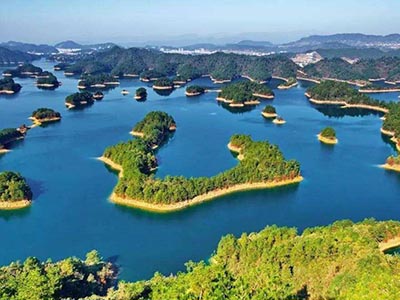West Lake One Day Tour
West Lake is surrounded on three sides by 'cloud-capped hills' and on the fourth by the city of Hangzhou. Its beauty has been celebrated by writers and artists since the Tang Dynasty (AD 618-907). In order to make it more beautiful, its islands, causeways and the lower slopes of its hills have been 'improved' by the addition of numerous temples, pagodas, pavilions, gardens and ornamental trees which merge with farmed landscape. The main artificial elements of the lake, two causeways and three islands, were created from repeated dredgings between the 9th and 12th centuries. Since the Southern Song Dynasty (thirteenth century) ten poetically named scenic places have been identified as embodying idealised, classic landscapes - that manifest the perfect fusion between man and nature. West Lake is an outstanding example of a cultural landscape that display with great clarity the ideals of Chinese landscape aesthetics, as expounded by writers and scholars in Tang and Song Dynasties. The landscape of West Lake had a profound impact on the design of gardens not only in China but further afield, where lakes and causeways imitated the harmony and beauty of West Lake. The key components of West Lake still allow it to inspire people to 'project feelings onto the landscape'. The visual parameters of this vast landscape garden are clearly defined, rising to the ridges of the surrounding hills as viewed from Hangzhou.
from
$75.00
Duration: 1 day
Tour Code: CE-HZ-1D01
Departure Date: Every day
Tour Attractions:Six Harmonies Pagoda, Meijiawu Tea Village, West Lake, 9 Creeks & 18 Gullies.
Feature:Natural Landscape, Photo Tour, Private & Custom Tour
Tour Type: /Land tour + Private English speaking guide + Private driver + Hotels
Tour Code: CE-HZ-1D01
Departure Date: Every day
Tour Attractions:Six Harmonies Pagoda, Meijiawu Tea Village, West Lake, 9 Creeks & 18 Gullies.
Feature:Natural Landscape, Photo Tour, Private & Custom Tour
Tour Type: /Land tour + Private English speaking guide + Private driver + Hotels
D1 Six Harmonies Pagoda / Meijiawu Tea Village / West Lake / 9 Creeks & 18 Gullies
Pick up from hotel, stop by the Six Harmonies Pagoda then proceed to the most striking structure in the city. visit the charming museum and take photos in front of this architectural marvel that was built in the Song Dynasty.
Then sightseeing in the Meijiawu Tea Village for a traditional tea ceremony and learn its significance to Chinese culture. After lunch, you will head for a cruise across the West Lake. Enjoy the beautiful view and experience peace and serenity like nowhere else in the Shanghai area. The unforgettable scenery includes Three Pools Mirroring the Moon, Bai and Su Causeways, Solitary Hill, and Lei feng Pagoda, etc. The boat ride ends at Viewing Fish at Flower Harbor.
Then walk along on Su Causeway, and feed the fish in the Red Fish Pond to pray for the good luck. Finally, experience the nature and visit "9 Creeks & 18 Gullies" where you may have a lovely walk and enjoy the peaceful environment. Discover the many quaint places to stop off along the way including a lagoon and a small pavilion which has been converted into a great tea and snack house.


Pick up from hotel, stop by the Six Harmonies Pagoda then proceed to the most striking structure in the city. visit the charming museum and take photos in front of this architectural marvel that was built in the Song Dynasty.
Then sightseeing in the Meijiawu Tea Village for a traditional tea ceremony and learn its significance to Chinese culture. After lunch, you will head for a cruise across the West Lake. Enjoy the beautiful view and experience peace and serenity like nowhere else in the Shanghai area. The unforgettable scenery includes Three Pools Mirroring the Moon, Bai and Su Causeways, Solitary Hill, and Lei feng Pagoda, etc. The boat ride ends at Viewing Fish at Flower Harbor.
Then walk along on Su Causeway, and feed the fish in the Red Fish Pond to pray for the good luck. Finally, experience the nature and visit "9 Creeks & 18 Gullies" where you may have a lovely walk and enjoy the peaceful environment. Discover the many quaint places to stop off along the way including a lagoon and a small pavilion which has been converted into a great tea and snack house.


|
Group Size |
1 Person |
2-4 Person |
5-6 Person |
6-9 person |
|
Price |
195 |
105 | 80 |
75 |
Our prices included:
1. Hotel Pick-up and drop-off
2. Air-conditioned tour vehicle
3. English Speaking tour guide
4. Typical Chinese lunch
5. Cruise boat ticket
Our prices not included:
Tips to the guide and driver
1. Hotel Pick-up and drop-off
2. Air-conditioned tour vehicle
3. English Speaking tour guide
4. Typical Chinese lunch
5. Cruise boat ticket
Our prices not included:
Tips to the guide and driver
Pick-up point and time: Your Hotel between 7:00am and 8:30am
Finishing point and time: Your Hotel around 6:00pm
If you require, we can book hotels in Chengdu, and make private airport and city tour necessary.
Are you interested in this itinerary? Send us a message and let us help you plan and book your China vacation based on this sample. Response within 24 hours. Contact our Travel Consultant.
Finishing point and time: Your Hotel around 6:00pm
If you require, we can book hotels in Chengdu, and make private airport and city tour necessary.
Are you interested in this itinerary? Send us a message and let us help you plan and book your China vacation based on this sample. Response within 24 hours. Contact our Travel Consultant.















